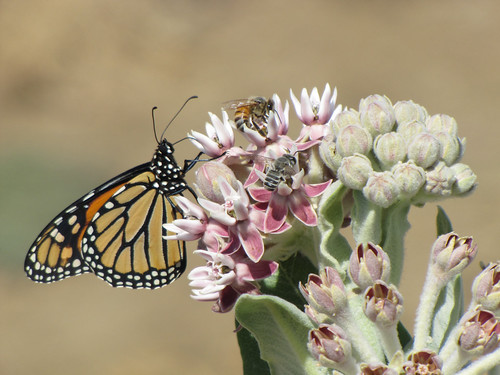
Tomorrow, USDA’s Natural Resources Conservation Service (NRCS) is joining the festivities at the sixth annual Pollinator Festival in honor of National Pollinator Week. Bees, butterflies, bats, birds, beetles and other animals play a critical role in the production of fruit or seeds, including plants that provide our nation’s food, fiber, fuel and medicine.
An estimated $15 billion worth of crops, including more than 90 fruits and vegetables are pollinated by honey bees alone. But despite their value, pollinator populations are dwindling due to threats of habitat loss, disease, parasites and environmental contaminants. That’s why farmers and ranchers are doing their part to improve the health of pollinators while providing benefits to the environment. Producers have worked with NRCS to voluntarily apply conservation practices on hundreds of thousands of acres of land because they know people and pollinators depend on each other for survival.
This year, NRCS will celebrate pollinators with other USDA agencies at an event in front of the USDA Whitten Building, near the People’s Garden and USDA Farmers’ Market. We will engage the public in discussing the importance of protecting pollinators and let them know about actions they can pursue at home or in their community.
Many can’t attend the celebration, so I’d like to introduce the world’s key pollinators and give some small tips to help protect them:
BEES
One out of every three bites of food Americans eat is pollinated by bees. Bees, like the threatened rusty patched bumble bee, pollinate our herbs and spices, and even succulent fruits including plum and cranberries. Midwestern crops like apples, clovers and alfalfa are pollinated by honey bees to produce fruit or seed.
BATS
Bats take the night shift as pollinators. They feed on sweet nectar from nighttime flowering plants, pollinating over 300 fruit species, including commercial crops like avocado, mangoes, agave and bananas. An important bat species facing population decline is the Mexican long-tongued bat, which visits up to 30 flowers each night to feed and, in the process, transports pollen.
BEETLES
Beetles are the largest set of pollinating critters, pollinating 88 percent of 240,000 flowering plants worldwide. They are also known as the “mess and soil” pollinators because they release waste within the flora. Beetles, like the threatened valley elderberry longhorn, are key pollinators for trees and shrubs like elderberry, magnolias and spicebush.
BUTTERFLIES
Butterflies take an artful flutter to pollinate their fair share of plants, resulting in seed and fruit production. They help pollinate vital herbal remedies like Echinacea. The Monarch butterfly is in decline due to lack of milkweed which they depend upon to feed and lay eggs.
HUMMINGBIRDS
Hummingbirds are the world’s key wildflower pollinators. They have the fastest metabolism of all animals, steadily feeding on the nectar of flowers and tiny arthropods. The decline in hummingbird populations like the endangered Honduran emerald is significant because they are crucial pollinators and can remember where to find their favorite food sources from previous years.
MOTHS
The fuzzy hair on moths, like the threatened kern primrose sphinx, makes them great pollinators. This hair helps them collect pollen from flora. Most moths work at night, pollinating your favorite snacks like cashew nuts and papaya.
Learn more about pollinators at: http://go.usa.gov/3kfrY.
